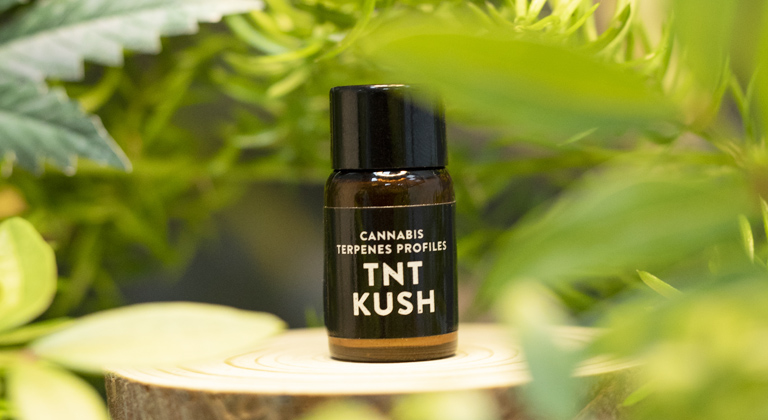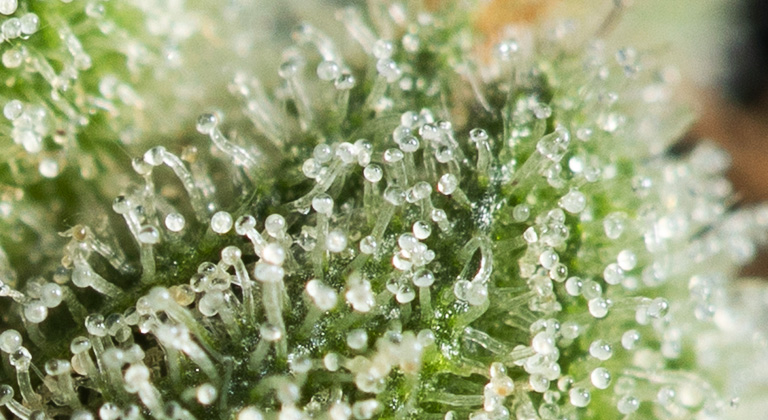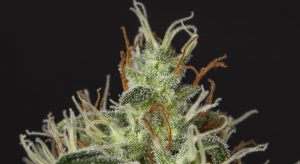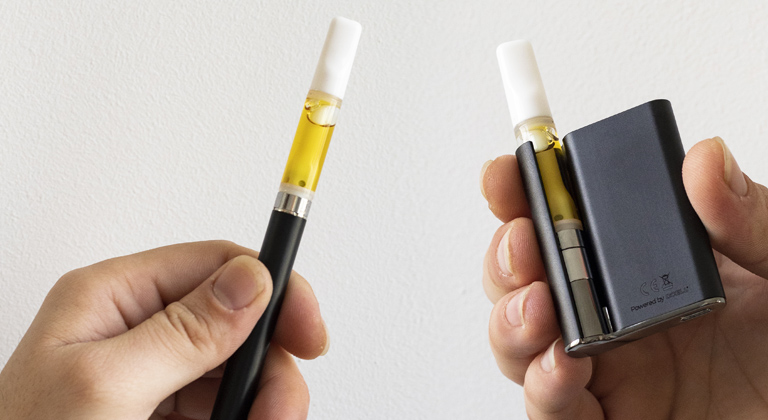One of the most frequently asked questions about terpenes, especially in relation to food products, is at what temperature they evaporate. In this article, we’ll talk about the volatile power of terpenes, and you’ll realise that it’s actually easier to work with them than you think… Because they’re volatile but not really that much!
Why Do Terpenes Evaporate?
Terpenes are molecules that create the aroma and flavor of countless plants and fruits in the plant kingdom, including cannabis.
Cannabis terpene profiles are richer and more complex than those of most plants because they combine a wider variety of terpenes. This is why the aromas of cannabis result in unique and complex flavors that captivate users from the very first tasting.
However, both the aromas and therapeutic properties of terpenes can be lost if they’re exposed to excessively high temperatures, as they can evaporate.
Why Is It Important to Know the Evaporation Temperature of Terpenes?
Knowing at what temperature these aromatic molecules are lost can save you a lot of hassle:
- If you’re a consumer of products containing cannabis terpene profiles, it’s important for you to know at what temperature you should store your products to prevent them from losing their aromatic quality and functional properties.
- If you’re producing or thinking about producing products with terpenes (like distillates, flowers, beverages, edibles, or cosmetics), it’s crucial to consider the evaporation temperature of terpenes to avoid exceeding it during production or storage.
Factors Affecting Terpene Evaporation
- Temperature: As temperature increases, terpenes evaporate faster. For instance, myrcene starts evaporating at around 166°C, while limonene begins to evaporate at about 177°C.
- Exposure to air: Contact with oxygen can accelerate the oxidation and loss of terpenes.
- UV light: Direct sunlight can degrade and evaporate terpenes over time.
- Storage time: The longer a product is stored without adequate temperature and humidity control, the greater the loss of terpenes.
Today we will focus on the first factor, i.e., the temperature at which terpenes evaporate.

Consequences of Terpene Evaporation
Whether with products with added terpenes, or with those that naturally contain terpenes (like cannabis flowers), you have to be especially careful with the temperature to prevent these aromatic molecules from evaporating. Terpene evaporation can lead to:
- Loss of aroma and flavor in flowers, extracts, or infused products.
- Reduction of the entourage effect, which is the interaction between terpenes and cannabinoids that enhances their therapeutic effects.
- Deterioration of product quality.
To minimize terpene evaporation, it’s recommended to store products in airtight containers in cool and dark places, and to avoid prolonged exposure to heat or air. Therefore, all our products are processed and packaged to ensure this doesn’t happen, maintaining maximum quality.
At What Temperature Do the Main Terpenes in Cannabis Evaporate?
In the terpene profile of cannabis, there’s a group of terpenes that are usually found in larger quantities. These are commonly known as the “main terpenes of cannabis”.
Terpene evaporation is the process in which these volatile compounds disperse into the air. Each of these molecules has different evaporation points depending on its chemical structure.
Pinene
Pinene is one of the most common cannabis terpenes, and is found in strains like OG Kush. In terms of therapeutic effects, this terpene showcases anticancer, antioxidant, and anti-inflammatory properties.
Evaporation Temperature of Pinene:
- Alpha Pinene: 155 to 156ºC
- Beta Pinene: 163 to 166ºC
Caryophyllene
Apart from being one of the main terpenes in cannabis, β-Caryophyllene is also found in other plants like black pepper and clove. This terpene is distinguished by a spicy, woody aroma reminiscent of clove. Its main therapeutic properties include anti-inflammatory, anticancer, and cytoprotective.
One of the strains with the highest concentration of β-Caryophyllene is Gorilla Glue.
Evaporation Temperature of β-Caryophyllene: 129 to 130°C.
Myrcene
Myrcene is one of the most abundant terpenes in cannabis, and is also found in other plants like hops and thyme. Its aroma is earthy, musky, and spicy.
Therapeutic properties:
- Sedative and muscle relaxant
- Pain reliever
- Anti-inflammatory
Evaporation Temperature of Myrcene: 166 to 167°C
Limonene
Limonene is a terpene with a distinctive citrusy aroma which is present in citrus fruits like lemon and orange, as well as in many cannabis strains like Nina Limone. Its therapeutic properties include:
- Anticancer
- Antifungal
- Protection against UV radiation
Evaporation Temperature of Limonene: 175 to 177°C.
Linalool
Linalool is the terpene responsible for the floral aroma characteristic of lavender, which is also present in other plants and cannabis strains like Girl Scout Cookies.
Therapeutic properties:
- Anticancer
- Anti-inflammatory
- Neurological agent
Evaporation Temperature of Linalool: 194 to 197°C.
Humulene
Humulene has an earthy and woody aroma reminiscent of hops. As you might have guessed, it’s also present in large quantities in this plant, as well as in others like cannabis (especially in some strains like Black Dream or 3 Kings).
Therapeutic properties:
- Insecticide
- Anticancer
- Antibacterial
Evaporation Temperature of Humulene: 166 to 168°C.
Terpinolene
Terpinolene is a terpene with a fresh and complex aroma that combines herbal, citrusy, and sweet notes. It is found in spices like nutmeg and cumin, and is highly present in “Haze” cannabis strains like Gipsy Haze or Super Lemon Haze.
Therapeutic properties:
- Sedative
- Antioxidant
- Antibacterial
- Antifungal
Evaporation Temperature of Terpinolene: 183 to 185ºC.
At What Temperature Do the Secondary Terpenes of Cannabis Evaporate?
While the terpenes detailed above are those most frequently found in larger quantities in cannabis profiles, there are also many other minor terpenes that also influence the aroma and therapeutic properties of cannabis.
These are the approximate evaporation temperatures for some of those secondary terpenes:
- Bisabolol: 153ºC
- Borneol: 210°C
- Camphene: 159°C
- Carene: 170°C
- Cymene: 177°C
- Eucalyptol (Cineole): 176°C
- Farnesene: 128°C
- Fenchol: 202°C
- Fenchone: approximately 171°C
- Guaiol: 154 ºC
- Eucalyptol: 176 to 177ºC
- Geraniol: 230ºC
- Isoborneol: 212°C
- Menthol: 212°C
- Nerolidol: 114°C
- Ocimene: 175°C
- Terpineol: 218°C
- Terpinene: 173 to 175ºC
- Valencene: 123°C
What Can I Do to Prevent Terpene Evaporation?
At Cali Terpenes, we specialize in all aspects related to the formulation and production of products that include terpene profiles.
Whether for brewing beverages like craft beers or energy drinks, or for 420 products such as distillates or flowers, our technical team provides support to our clients to ensure the final product retains all the aroma, flavor, and functional properties offered by our terpene profiles.
If you’re considering creating your own line of products with terpenes, do not worry: we’ll review your case and guide you through the entire process, providing precise instructions on how and when to add them during the manufacturing to avoid the risk of evaporation.
In summary, if you don’t want your terpenes to evaporate:
- Always work at appropriate temperatures.
- Store terpenes or flowers/extracts away from sunlight and in a cool place. Terpenes should be stored in a cool place or refrigerator, not in the freezer.
- Once you use your terpenes, store them again with all the safety measures included in the containers (sealing cap, screw cap, etc.).
In cannabis flowers, terpenes aren’t in gaseous form within the trichomes, but they are volatile compounds, meaning they have a high vapor pressure even at room temperature. This means that, even if they are in liquid form (dissolved in the trichome resin), part of them always tends to evaporate and transition to the gaseous state, even if they haven’t reached their boiling point.
So, here’s what happens:
- Inside the trichomes, terpenes are mostly found in liquid form, mixed with cannabinoids and other “resin” compounds.
- When the trichomes break or are exposed to air, terpenes evaporate quickly due to their high volatility, even if their boiling point hasn’t been reached.
- This evaporation is what enables you to perceive the aroma: molecules of terpenes in gaseous state come into contact with your olfactory receptors.

Did you find this article useful? Do you have any questions? Leave a comment and share your opinion with the community!
Cali Terpenes








